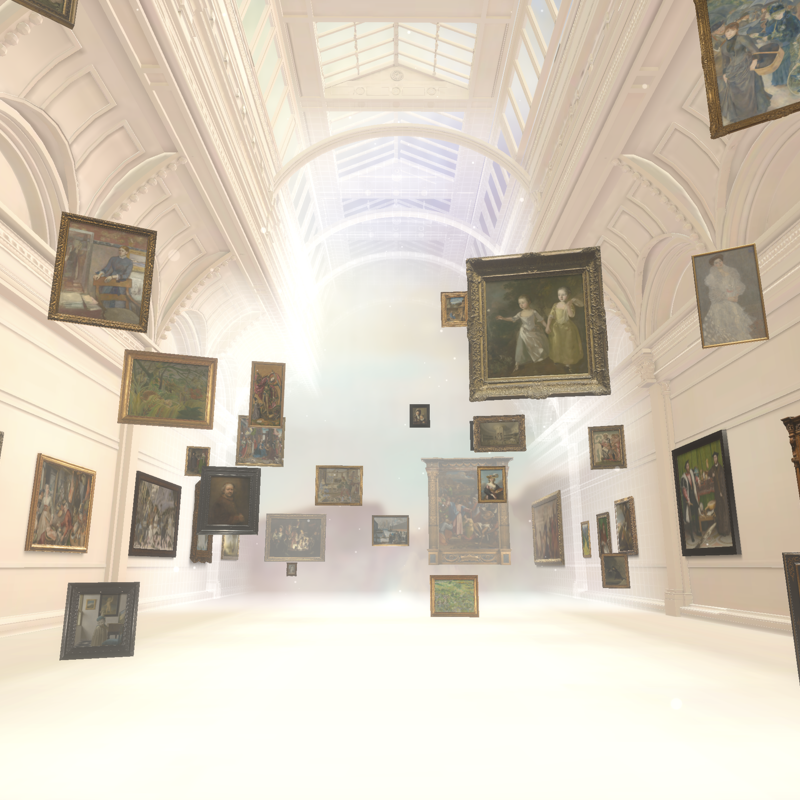Thomas Gainsborough, 'The Painter's Daughters chasing a Butterfly', probably about 1756
About the work
Overview
The two little girls in this unfinished portrait are Mary and Margaret, Gainsborough’s daughters by his wife, Margaret Burr, and their only children to survive infancy. Mary was baptised on 3 February 1750 and Margaret on 22 August 1751. Mary was given the name of the couple’s first daughter, who died at about 18 months old.
Margaret and Mary run hand-in-hand through dark woodland in pursuit of a cabbage white butterfly, which has landed momentarily on a tall thistle. Margaret reaches out her hand, while Mary clutches her looped-up muslin apron as a net. The children’s attempt to catch the elusive butterfly may be intended to suggest the fleeting nature of childhood, and the fragility of children’s lives. The wood in Gainsborough’s picture is dark and sombre.
This is probably the earliest of at least six double portraits that Gainsborough painted of his daughters between about 1756 and 1770.
Key facts
Details
- Full title
- The Painter's Daughters chasing a Butterfly
- Artist
- Thomas Gainsborough
- Artist dates
- 1727 - 1788
- Date made
- probably about 1756
- Medium and support
- oil on canvas
- Dimensions
- 113.5 × 105 cm
- Acquisition credit
- Henry Vaughan Bequest, 1900
- Inventory number
- NG1811
- Location
- Room 34
- Collection
- Main Collection
- Frame
- 20th-century Replica Frame
Provenance
Additional information
Text extracted from the ‘Provenance’ section of the catalogue entry in Judy Egerton, ‘National Gallery Catalogues: The British Paintings’, London 2000; for further information, see the full catalogue entry.
Exhibition history
-
2011Family Matters: The Family in British ArtNorwich Castle Museum & Art Gallery15 October 2011 - 8 January 2012Millennium Gallery2 February 2012 - 29 April 2012Laing Art Gallery19 May 2012 - 2 September 2012
-
2014Making ColourThe National Gallery (London)18 June 2014 - 7 September 2014
-
2018Gainsborough's Family AlbumNational Portrait Gallery (London)22 November 2018 - 3 February 2019
-
2023Finding FamilyThe Foundling Museum17 March 2023 - 27 August 2023
Bibliography
-
1856G.W. Fulcher, Life of Thomas Gainsborough, R.A., London 1856
-
1946Davies, Martin, National Gallery Catalogues: British School, London 1946
-
1946M. Davies, Paintings and Drawings on the Backs of National Gallery Pictures, London 1946
-
1959Davies, Martin, National Gallery Catalogues: British School, 2nd edn (revised), London 1959
-
1961M. Woodall (ed.), The Letters of Thomas Gainsborough, London 1961
-
1975M. Levey, Gainsborough: The Painter's Daughters chasing a Butterfly (exh. cat. The National Gallery, 9 October - 23 November 1975), London 1975
-
1980J.T. Hayes, Thomas Gainsborough (exh. cat. Tate Gallery, 8 October 1980 - 4 January 1981), London 1980
-
1981M. Rosenthal and M. Myrone, Gainsborough, 1727-1788 (exh. cat. Tate Gallery, 7 October 1980 - 4 January 1981; Grand Palais, 6 February - 27 April 1981), Paris 1981
-
1982J.T. Hayes, The Landscape Paintings of Thomas Gainsborough: A Critical Text and Catalogue Raisonné, Ithaca 1982
-
1983J.T. Hayes and L. Stainton, Gainsborough Drawings, (exh. cat. National Gallery of Art, Washington, 1983), Washington 1983
-
1987E. Einberg, Manners and Morals: Hogarth and British Painting 1700-1760 (exh. cat. Tate Gallery, 15 October 1987 - 3 January 1988), London 1987
-
1991M. Cormack, The Paintings of Thomas Gainsborough, Cambridge 1991
-
1991National Gallery, 'Queen's Collection Double Portrait', National Gallery News, 1991
-
1991D. Tyler, 'Thomas Gainsborough's Daughters', Gainsborough's House Society Annual Report, 1991, pp. 50-66
-
1992D. Tyler, 'The Gainsborough Family: Births, Marriages and Deaths Reexamined', Gainsborough's House Review, 1992, pp. 27-32, 38-54
-
1992D. Tyler, 'Thomas Gainsborough's Days in Hatton Garden', Gainsborough's House Review, 21, 1992, pp. 27-32
-
1995J.C. Steward, The New Child: British Art and the Origins of Modern Childhood, 1730-1830 (exh. cat. University Art Museum and Pacific Film Archive, 23 August - 19 November 1995; Dixon Gallery and Gardens, 10 December 1995 - 4 February 1996; Joslyn Art Museum, 9 March - 5 May 1996), Berkeley 1995
-
1998J. Egerton, The British School, London 1998
-
1998J.T. Hayes, Thomas Gainsborough (exh. cat. Palazzo dei Diamanti, Ferrara, 7 June - 30 August 1998), Ferrara 1998
-
1999A. Asfour and P. Williamson, Gainsborough's Vision, Liverpool 1999
-
1999National Gallery, Children in Art, London 1999
-
1999M. Rosenthal, The Art of Thomas Gainsborough, Yale 1999
-
2000Egerton, Judy, National Gallery Catalogues: The British Paintings, revised edn, London 2000
-
2001
C. Baker and T. Henry, The National Gallery: Complete Illustrated Catalogue, London 2001
-
2002M. Postle, Thomas Gainsborough, London 2002
-
2002S. Sloman, Gainsborough in Bath, New Haven 2002
-
2002M. Rosenthal and M. Myrone, Gainsborough (exh. cat. Tate Britain, 24 October 2002- 19 January 2003; National Gallery of Art, Washington, 9 February - 11 May 2003; Museum of Fine Arts, 9 June - 14 September 2003), London 2002
-
2003A. Graham-Dixon, In the Picture: The Year through Art, London 2003
-
2005Holburne Museum of Art, Pictures of Innocence: Portraits of Children from Hogarth to Lawrence (exh. cat. Holburne Museum of Art, 22 March - 19 June 2005; Abbot Hall Gallery, 12 July - 8 October 2005), Bath 2005
Frame
This is probably a twentieth-century English replica frame made in the Rococo style. Carved from pinewood, it features stylised, pierced leaf corners and swept outlines that converge at the centre with intricate leaf and husk details. The hollow is adorned with an undercut continuous shell pattern. The sight edge is decorated with a French-style acanthus-leaf motif.
The frame was altered by Robert Sielle of London in 1935 to fit Gainsborough’s The Painter’s Daughters chasing a Butterfly. It was entirely regilded at the same time. Some silver is visible on the reverse of the corners, although it is unconfirmed whether this is original or a later addition.
About this record
If you know more about this painting or have spotted an error, please contact us. Please note that exhibition histories are listed from 2009 onwards. Bibliographies may not be complete; more comprehensive information is available in the National Gallery Library.













